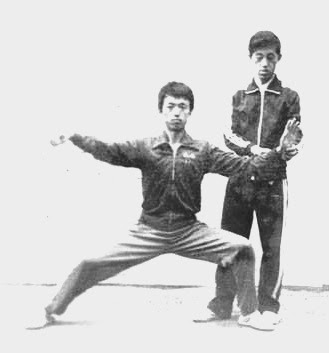 |
| Searching for the fine details of posture- a young instructor in the Chenjiagou Taijiquan School correcting Zhan Zhuang |
At the same time, like any other martial art, Taijiquan requires
them to set their sights high if they are to develop real and effective skills.
Simply, they must approach training with ambition. The first time I trained in
China back in 1997 I bought a bootleg disc of Wang Xian and his disciples
demonstrating the breadth of the Chen Taijiquan system. To say I loved the disc
would be an understatement! At the time my eyes were untrained to many of the
subtleties of Taijiquan, but it had everything - power, speed, coordination and
a tight focus and togetherness when
groups of instructors demonstrated. The last performance was Wang Xian himself explosively
demonstrating the Xinjia Yilu on the banks of the Yellow River. When he reached
the end of the form and quietly closed, the following simple message played across
the screen- “If you want to be better than everyone else, train harder than
everyone else” - pretty ambitious right?!
Going back a further generation Chen Zhaopi, the teacher most
credited with sparking the modern resurgence of Taijiquan in Chenjiagou,
described an individual’s progressive advancement from beginner to advanced
practitioner via three stages: in the first, a learner must open their joints
training the overtly physical aspects of the art; the second stage encompassed
the long journey of understanding Taijiquan’s neijin or internal energy; the
third he described as “continuous movements executed in one breath.” This
elevated level represented the height of perfection: with a complete integration
of form and spirit; body completely balanced and unrestrained; and movements
natural and instinctive. Reaching this level is referred to as shen ming, or "divine
realisation".
 |
| A youthful Chen Zhenglei teaching the next generation |
Getting down
to day-to-day training we’re told to relax and not to “try” too hard; to be
natural and don’t force it; to cast aside stiff energy etc. All the while
continually having our frame adjusted to a place where the legs are literally
trembling with the effort. I remember a training session with Chen Xiaowang
where someone asked about the pain they were experiencing in their legs and if
it ever got easier. His oblique answer was simply to say, “don’t put so much
importance on the pain in your legs.” In other words, just because the legs are
hurting no need to add to that by fixating on it. If you’re doing Taijiquan
properly your legs are going to work hard. Taijiquan has a saying “concentrate on one thing lose everything.” No matter how hard you train if you
pay too much attention to any one thing you will move away from the ultimate
aim that is no less than the total integration of internal and external,
physicality and consciousness.
Taijiquan itself makes no apologies for its paradoxical nature. The
very name of the system is drawn from the philosophical concept of Taiji – it
is the martial art of balance and change. It is up to each individual to
reconcile the apparent contradictions for themselves. This area probably
confounds western Taijiquan students the most. For example many athletically
able students are overly concerned with external appearance and shape – whether
it be in terms of strength, flexibility etc. It’s there that they get their
positive strokes from others who also don’t see the whole picture. And to be
very clear this is not to diminish the fundamental importance of strength,
flexibility etc. This type of student can find it very hard to open up their
mind. During a training session with one of the younger generation teachers from Chenjiagou, a
strong and flexible individual stretched out into a wide and low posture. The
teacher’s correction was to lift the posture up and advise him to put
attention to loosening his kua and
rounding his dang (crotch). Although
the position was low, it was locked in such a way that the dang strength that is a vital part of Chen Taijiquan was totally
lacking. The immediate response – “What exercise can I do to loosen it?” -
completely missing the point that this was not something that was going to be
corrected by grinding out some reps.
 |
| Another face of Taijiquan - Chen Zhaokui traing qinna |
Taijiquan
is built around the qualities of agility and changeability. It requires us to
aim high but at the same time do today’s work.
Chinese culture is imbued by the Daoist tradition and an acceptance of
seemingly contradictory aspects if we are to see a thing in its entirety. The
following passage from the Inner Chapters of Zhuangzi point simultaneously to
the need for careful instruction, effort and time while being mentally calm,
free and ungrasping.”
“Neither
deviate from your instructions, nor hurry to finish. Do not force things. It is
dangerous to deviate from instruction or push for completion. It takes a long time to do a thing properly. Once
you do something wrong it may be too late. Can you afford to be careless? Follow
with whatever happens and let your mind be free; stay centred by accepting
whatever you are doing. This is the ultimate… It is best to leave everything to
work naturally…”



No comments:
Post a Comment